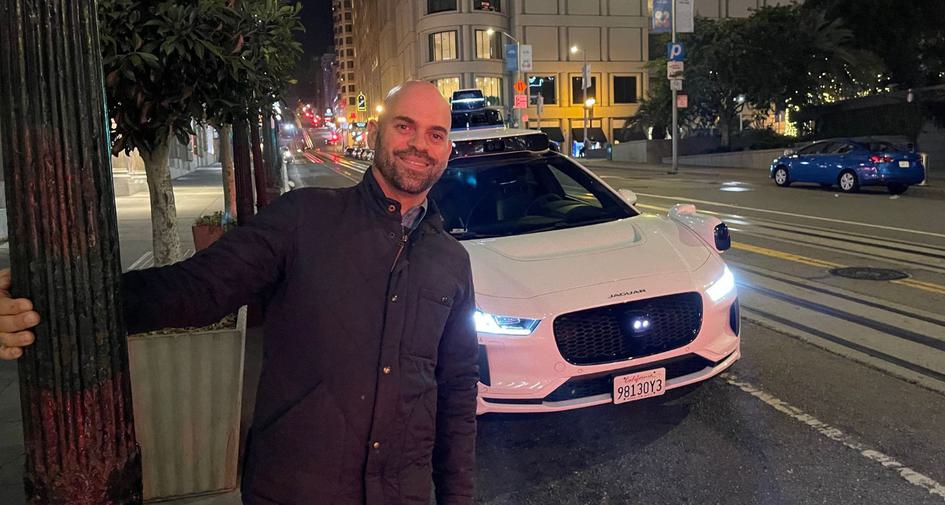Waymo… Cash Flow

(by Carlos Vega, CEO and Co-Founder of Tesorio)
What did my first ride in a Waymo have to do with cash flow?
I experienced reality-shifting technology for the second time in less than two years: The first was ChatGPT in late 2022. The second was recently when my co-founder & I rode a Waymo for the first time.
I downloaded the app, set up my account, and boarded a car with no driver in less than seven minutes. The car showed up and the UI in the app was intuitive. I loved the honk button—I pressed it five times like a toddler at a steering wheel for the first time. But that was just the beginning: accelerating, turning, braking, and parking were all smoother than an Uber.
It felt like I had time-traveled to the future.
To be fair, there were a couple of close calls. A biker blew through a red light at an intersection yet the car smoothly stopped as if it knew it would happen. Later we accelerated through a yellow light across four lanes of traffic—my heart skipped a beat that time. But these situations got us thinking...
As we watched the on-board screen, we noticed how much further the car could see than us. We saw Waymos on every block and started wondering: what if in the near future they’re all connected? What if a Waymo hivemind could aggregate all the data each car gathers, sharing it dynamically and instantaneously? We nervously joked, what if we sped through that intersection because there was another Waymo ‘watching’, and using that other car’s data, ours knew it was safe to proceed? We were kidding at first, but we were onto something.
We called this idea a “Sensory Network”. So much about driving depends on your reflexes, keeping you in a reactive state. Maybe Google Maps helps you avoid a traffic jam, but you still need to stay alert because randomness and surprises are everywhere. The current state of autonomous vehicles is also a reactive system designed to navigate human unpredictability. But it won’t be for long, nor will other systems.
Imagine an order of magnitude more Waymos on the road in the near future, sensing and structuring the randomness around them and every Waymo being capable of sharing and tapping into that mesh of data. Consider that it’s in the interest of all autonomous vehicle manufacturers to make their products safer. While they will each have their networks, it’s logical that some level of data sharing will eventually occur. Every car on the road will be a sensory node, enmeshed within this dynamic network.
The more cars, the more randomness is transformed to data, and the less entropy in the system. Cars would speed past each other and there would never be gridlock. A car approaching an intersection would slow down 0.5 miles per hour imperceptibly to let the approaching car that’s coming zip past and then accelerate through. Autonomous driving will be less and less about reacting to the unexpected, and more about pathfinding through a progressively less random world.
Once you see it you can’t unsee it; it makes too much sense not to exist. As machines expand our ability to map randomness in our world, Sensory Networks will emerge for various aspects of life. Human-machine versions already exist, for example, with Air Traffic control plus the Traffic Collision Avoidance System (TCAS) on planes. The amount of data that can be mapped and understood will continue expanding, and processing velocity will make Sensory Networks even more valuable—and critical—over time.
So what was it that Waymo had to do with cash flow?
My take is that cash flow is a data problem, not a finance problem. The financial operations of a business have been digitized to the point where the data for almost all cash flowing in and out of a business exists—it just needs to be structured and deciphered. A Sensory Network is waiting to emerge in finance, but the pieces have to be stitched together.
Think about it:
- NetSuite has every invoice and bill you’ve ever booked, those you have yet to collect & pay, and a record of all cash flows in and out of your business.
- Salesforce has data about what new customers could be coming in, who’s up for renewal, and copies of contracts you signed with your customers.
- Intercom & Zendesk have support communications with your customers and information about their well-being or lack thereof.
- Outlook & Gmail have all other communications with customers, vendors, employees, and other stakeholders about planned transactions.
- Zuora has billing schedules and subscription data from every customer.
- Coupa has your purchase orders, utilization, and installment schedules for each customer.
- ADP & Workday have your payroll and headcount plans.
- Captivate IQ & Xactly have your commission history and plans.
- OneStream, Planful & Adaptive Insights have all your meticulously crafted operating plans developed with each manager.
- And so on…
This is possible today. LLMs are to cash flow as LiDAR was to autonomous vehicles. One by one these data points will be stitched together and the thousands of actions that impact cash flow will be mapped. Initially, there will be a sensory network within your company’s data, and then eventually across companies. The result? Cash flow will stop being unpredictable and our dollars will whiz past each other like autonomous vehicles through an intersection of the future.